Considerations from Dipl.Math. Ulrich Meyer, Februrary 2020 To the main side:
 To German
text:
To German
text:

4. Continuation of
the
Considerations from Dipl.Math. Ulrich Meyer,
Februrary 2020
To the main side:
![]()
 To German
text:
To German
text:

Results
from recent scientific knowledge.
Some aspects are from the book "The God Theory" by Bernard
Haisch (2009) and
from
the book "A universe from nothing" by Lawrence M. Krauss (2013).
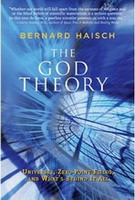
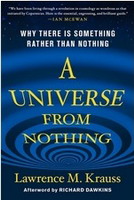
By unclear
technical terms you can click for more
information on the internet or you look for the words by Google or
YouTube.
Our universe was created from one point by the
Big Bang. The matter of the universe could be created out of nothing by
quantum fluctuations.
The whole process and the further development to the formation of our
galaxy, the Milky Way, our planet and us humans, through the evolution,
was produced independently without a creator, without the so-called
"God" (See: "
Who is god? Part 3").
We now want to examine what this creation and development process still
means for us today.
For this we want to
take a closer look at these quantum fluctuations, our origin. What does
fluctuation actually mean? The term comes from the
latin word "fluctuare", which means a short or constant change, a
short variation. The quantum fluctuations are also indicated as
zero point energy in a zero point field.
In a vacuum, in a nothing, where there is nothing, absolutely nothing,
there is something. There is no nothing, because in every "nothing"
particles and their antiparticles are constantly being created, but
shortly afterwards they annihilate each other, this means they destroy
themselves, and thus they disappear again. These particles are called
virtual particles, because they do not really exist and therefore they
cannot be measured. They are spontaneous fluctuations of a quantum
field, which can be converted by an energy supply above a threshold
value to real particles, if they have not destroyed themselves
previously. To show this better, we need a quantum mechanical
explanation. Quantum mechanics came
about, because it was found out that nature is not
continuous, but is quantified in detail. Everything like space,
matter, time, light, energy and electrical charge consists of smallest
portions, the quants, not equal to zero. In the vacuum, in the
"nothing", a field energy must be unclear after Heisenberg's uncertainty principle,
this means the energy oscillates around zero.
There can arise positive and negative particle pairs, because they
borrow energy from these energy fluctuations, which they give back
later with their annihilation again. The energy required for the
generation of the particle pairs is covered by the Heisenberg
uncertainty principle, so that there is no violation of the law of
conservation of energy. According to this, an amount of energy ΔE
may violate this energy conservation law over a period of time Δt
as long as the product of ΔE and Δt is
not greater than
or equal to the Planck's
constant divided by 4π.
It must ally:
ΔE x
Δt
≤ h/4π = ħ
(= reduced Planck's constant).
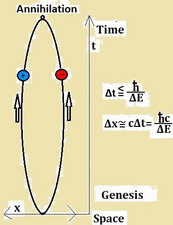 virtual
particles
virtual
particles
By the equivalence of mass and energy (E = mc²) there can arise
spontaneously such particles for a limited period of time. Because of
their very short lifetime and the fact
that their existence contradicts the basics of classical physics (the
energy conservation), such particles are called virtual particles.
They are transients, something temporary, while real particles are
stimulations of a quantum field whose existence can be measured.
In our practice we
could
create a vacuum in a closed container, if
everything, that can be removed from it, is removed from it, this means
all atoms and molecules. Then this container would not be empty,
because
new particles and their antiparticles are spontaneously created there,
but they immediately disappear again.
Our universe is relatively empty, this means there is a lot of empty
space
between the galaxies, the stars and the planets and other matter
accumulations. An electron, that moves along the border of a galaxy
cluster, would meet another electron all 22 million years because of
this void [See note 1)]..
But there is also a lot of empty space in our vicinity. Everywhere,
where there is no matter, the space is empty. So in our atmosphere, the
air, between the gas molecules like oxygen, carbon dioxide, nitrogen
etc. there is a lot of empty space.
But there is empty space in matter itself. Matter consists of atoms and
these consist of the atomic nucleus, which is composed of protons and
neutrons, and the electrons in the atomic shell, which are buzzing
around this nucleus. The shell has a size of about 10-10m
and the
diameter of the nucleus is 10-15 to 10-14m. This
does not sound at first as a big difference, but so the atomic shell is
more than 20,000 times to
100,000 times greater than the
nucleus. For better understanding we
assume that the atomic shell would have a diameter of 1 km, then the
size of the nucleus would be only 4 cm. Even more vividly than such a
pure size comparison in km and cm is the example that the
astrophysicist Professor Harald Lesch often uses. If an atom has the
size of a football stadium,
the nucleus would correspond to a grain of rice at the kick-off point
in the middle of the stadium field. The electrons would circle around
the outer stands. That is very remarkable. If you still consider that
the mass of a Elektron is only 1/1836 of the mass of a
proton, then it is also still significant smaller than the nucleus. The
mass of an atom is at most determined by the nucleus. If you visualize
all of this, you understand that there is a lot of empty space in every
atom. In all this empty space in the universe and in matter there are
these quantum fluctuations, that is to say, that there always arise
spontaneously particle pairs, which then immediately destroy
themselves.
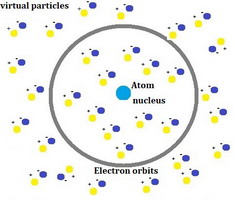 virtual particle pairs in an atom and
around - everywhere in the empty
virtual particle pairs in an atom and
around - everywhere in the empty
We, our inside and
our
surroundings, are always mixed with this quantum foam from
fluctuations. Therefor the question arises, whether these
short-term virtual particles have an impact on us and if so, which
one? From an energetic point of view, such a virtual particle is almost
insignificant, since you cannot measure it at all (see above).
However, there may be the possibility that an effect can arise in the
accumulation of many virtual particles.
Such an influence on physical parameters can be seen in the "Casimir-Effekt", which is often used to
demonstrate
vacuum fluctuations. A very
weak attractive force acts on two parallel conductive plates, Which are
lying very close together in a vacuum.
An example of the effect of vacuum fluctuations from our
daily life
can be seen in fluorescent lamps. These are filled with an inert gas
such as neon or argon through which an electron current is sent. The
electrons collide with the gas atoms and brings these into a
quantum-mechanically excited state. The noble gas atoms should actually
remain in this excited state, but then there will be no light. The
scientists realized much later, that it was only through the
interaction of the quantum fluctuations with the gas atoms that the
excited state was unstable and the atoms returned to the ground state,
and by this photons were emitted. Therefor the fluorescent lamps lights
up.
Let us now consider a single electron in a vacuum. This has
a negative charge. In the immediate vicinity of the electron, these
virtual
particle pairs are continuously created by the quantum fluctuations.
The
particle pairs are charged positively and negatively. The same charges
repel each other and the uneven charges attract each other. That means
the positive particles of the fluctuation turn towards the electron and
the negative particles turn away from the electron. These pairs of
particles only exist for a very short time, but there arises always new
particles. We then have two envelopes around the electron, a positively
charged and a slightly larger outer negative envelope made of
fluctuating particles. This behavior of the quantum fluctuations to
electrons also exists in every electronic circuit in a corresponding
adaptation to the environment. If you measure the outgoing pulsation of
an electronic circuit, you will always find a very low background noise
there. This is based on the influence of quantum fluctuations on the
flowing through electrons.
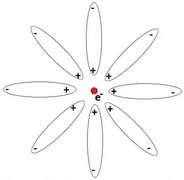 An electron polarizes virtual particles of
the quantum fluctuations
An electron polarizes virtual particles of
the quantum fluctuations
The C14 or radiocarbon analysis is a well-known
method for determining the age of fossils that are many thousands of
years old. The principle is to determine the ratio of C12 to C14
carbon. The proportion of C14 in the total
carbon deposits on earth is far below one percent, but this can be
easily determined using various methods. At about one billion C12
nucleuses there is one C14 nucleus. Normally carbon has six protons and
six neutrons and is therefore called C12. C14 is produced, when cosmic
radiation hits on
the upper Earth's atmosphere and nitrogen N14 is transformed to C14, by
exchanging a proton to a neutron. This C14 has the same
chemical properties as C12 and also occurs as carbon dioxide, but it is
unstable and therefore slightly radioactive. The half-life of C14 is
5730 years, this means after about 5730 years the half of a C14
amount
is decayed in a beta-minus decay back to
N14 and an electron and energy.

Because of this decay, the age of fossils can be
determined.
While in these, the C14 content is lower because of its decay as in
living organisms that have a fixed ratio of C12 to C14, which is kept
constant by the continuous respiration. The half-life of 5730 years
means that a C14 atom should normally decay to N14 in about 5730 years.
But this can also
happen in half or double time or at any other time. On average, a C14
decays to N14 is in 5730 years. But why does a C14 atom decays? It
doesn't
snooze so easily and often looks at a calendar and after about 5730
years it says to himself, it is time to take off. The kick-off and
timing for this decay was only understood in the
context of quantum electrodynamics. The nucleus of
C14 is in a state of
higher energy that he gets by his formation by cosmic radiation.
According to the rules of quantum mechanics, a state of higher energy
is also stable in the absence of external disturbances. But the
influence of the quantum fluctuations on the C14 nucleus causes it to a
spontaneous decay into N14. This process is very similar to the
above of the fluorescent lamps.
In
the listed
previous examples there are some effects of quantum fluctuations
described. However, these are mainly limited to the atomic range. They
affect an atomic nucleus or electrons. In the macroskopic area in our
daily life for us humans, these quantum fluctuations are not
immediately
noticeable. In any case, I don't know anything yet. Perhaps there will
be later new research results. One can only speculate whether the
quantum fluctuations, for example, can alter genes and could trigger a
spontaneous cancer, whose cause is unknown, or if they could cause
mental disorder or cause something
else. Quantum physicists also regard
the zero point field as an explanation for phenomena such as telepathy,
premonitions, synchronicity, spiritual
or self-healing. This could also apply to quantum
entanglement. Many unexplained events in the world were possibly
produced by quantum fluctuations. Perhaps the miracles, which are
reported in the Catholic Church and which are partly also recognized
and which may also be true, may have caused by the
zero-point energy.
But, as I said, these are all just speculated options that
could be
affected by the quantum fluctuations. If there is something to be true,
this would have to be proved, and that is not easy, because the quantum
fluctuations themselves cannot be measured. They can only be verified
indirectly.
And then we come back to our original question "Who is
God?".
There is no God as a creator of the universe and humans
(after part
3).
The physicist Richard Feynman, of whom some thought that he was
perhaps the only scientist who understood quantum mechanics, said: "God
was invented to explain puzzles. God is always invented to explain
things, you don't understand."
The universe was created out of nothing from quantum
fluctuations and
these permeate the universe and also us constantly in the empty space
that exists almost everywhere. The quantum fluctuation fulfill the role
of the creator and they exist everywhere.
This reminds me of one of my speculation from Part 1 of
"Who is God?"
from 2001, in which we didn't have the new knowledge of today. In
Chapter 4. "Where is God?" it is called:
"It couldn't be answered
completely. We can regard however its effects.
Since God is omnipresent, he should be present 'everywhere'.
What exists 'everywhere' ? - stuff (this is
masses).
And masses is equal energy by Einstein's relativity theory and
is everywhere in the universe distributed. If we come, nevertheless,
back to the picture of God as an old man, we could regard the energy
accordingly as a hand or an arm of him. Energy is responsible for all
processes."
This former speculation is today not full true, but it is
similar to our present knowledge in the structure in an amazing way,
because our Creator replacement, the quantum fluctuations, are
everywhere, and they show yet its effect, also if in a very small way
(look upstair).
But these effects do not come from an intellect and
spirit, which is assumed of God, but these effects occur spontaneously
or statistically. By the problems in the world, the humanity is
responsible for their own actions and they can not rely on help of God,
that cannot be. This is especially important today with the current
problem of climate change. Mankind must take care of its own
survival.
In the end, we can answer our initial question "Who is God?".
There is no god in the sense of religion as the creator and
superior administrator and guard of the universe.
Prof. Stephen Hawking already said, that God is in the laws of nature,
which comes closer to the matter.
(Stephen Hawking: "There's
no God.")
We have a causer of the universe. These are the quantum
fluctuations and
they still exist everywhere and they also have rare minor effects only
at the atomic level. The quantum fluctuation can only give kick-offs,
which are then determined by natural laws. But due to the Heisenberg
uncertainty principle, the process is not clearly predetermined,
but
different paths can be taken at random. [See note 2)].
Our "God" is in the structure of nothingness due to quantum
fluctuations or zero-point energy.
[1]
:
From Harald Lesch's
Book "Universe for
the curious"
[back]
[2] : Such
different paths existed already at the beginning of the
universe after the inflation (see part 3), since the distribution of
matter in the expanding universe was not uniformly homogeneous, because
then
we would not exist. Rather, as a result of the quantum fluctuations,
there
were regions with minimally slightly higher and lower matter density of
matter, from which stars and galaxies and thus our solar system could
later be formed.
[back]